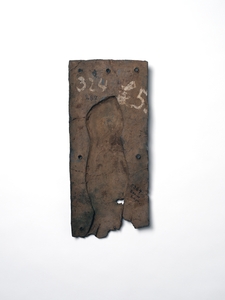Linden-Museum Stuttgart: 005384
| Linden-Museum Stuttgart: 005384 License: Attribution-NonCommercial-ShareAlike 4.0 International (CC BY-NC-SA 4.0) |
|
| Linden-Museum Stuttgart: 005384 License: Attribution-NonCommercial-ShareAlike 4.0 International (CC BY-NC-SA 4.0) |
|
Object description
This information was provided by the German museum where the object is currently located or where it was located prior to restitution.
| Object Name | High relief (copper alloy) plaque depicting a fish |
| Description | This relief plate from the royal palace shows a lungfish (Protopterus annectens or aethiopicus) next to the ornamental rosettes in the form of the symbolic number four. This symbolic animal stands for the special, "supernatural" powers of the king and the spiritual powers, as well as for the connection between water and land. In fact, thanks to its lungs, the fish can survive up to 4 years when its waters dry up. To do this, it digs itself into the still-wet ground and forms a mucus cocoon that protects the body from drying out. In a trance-like sleep, it feeds on the protein stores in its tail. Text: Dietmar Neitzke. |
| Type | Relief |
| Materials | Copper alloy |
| Size, Dimensions | Length: 40 cm. Width: 17.5 cm. |
| Dating of Object |
Museum / Collection / Acquisition
This information was provided by the German museum where the object is currently located or where it was located prior to restitution.
| Museum | Linden-Museum Stuttgart |
| Museum Inv.-No | 005384 |
| Collector | Felix von Luschan (Berlin) purchased a large number of royal objects produced in the Benin Kingdom and sold parts of the collection to other museums. The objects reserved for Stuttgart were paid by Karl Knorr (Heilbronn, Germany). |
| Acquisition date | 1899 |
| Circumstances of acquisition | In October 1898, the Hamburg company "H. Bey & Co" offered the Berlin Ethnological Museum a Benin collection that came directly from Africa. However, due to a lack of funds, the entire collection could not be purchased and was therefore to be passed on to other interested parties. Felix von Luschan of the Berlin Museum therefore informed Karl Graf von Linden in November 1898, and offered him a right of first refusal. The Linden Museum then made 15,000 M available for the purchase of objects. The purchase price was paid by the Heilbronn entrepreneur Karl Knorr, which is why the collection became known as "Die Karl Knorr'sche Sammlung von Benin-Altertümern". Von Luschan published a detailed description of the collection under the same title (1901) on behalf of Count Linden and Knorr. Other buyers of the collection included the museums in Vienna and Munich, but also people such as Hans Meyer (Leipzig) and Eugen Rautenstrauch (Cologne). Text: Markus Himmelsbach. |
| Notes |
Current ownership status and location
| Status | restituted |
| Date of last status change | 14 December 2022 |
| Current ownership | Federal Republic of Nigeria |
| Holding institution | National Commission for Museums and Monuments (NCMM, Nigeria) |
| Current location | Temporarily at the Linden-Museum Stuttgart |
Categorization for the search functions
This information was included by the German Contact Point for Collections from Colonial Contexts and is intended to make the object easier to find in the database.
| Object Type | relief |
| Materials | metal; copper alloy |
| Tags |
Dataset
| ID | 124 |
| last Change | 2023-01-26 12:15:00 |
| License | Linden-Museum Stuttgart |

